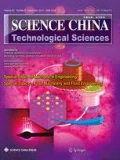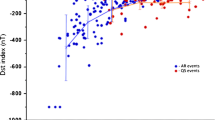Abstract
Using 80 CME-ICME events during 1997.1–2002.9, based on the eruptive source locations of CMEs and solar magnetic field observation at the photosphere, a current sheet magnetic coordinate (CMC) system is established in order to study the propagation of CME and its geoeffectiveness. In context of this coordinate system, the effect of the eruptive source location and the form of heliospheric current sheet (HCS) at the eruptive time of CME on the geomagnetic storm intensity caused by CME and the CME’s transit time at the Earth is investigated in detail. Our preliminary conclusions are: 1) The geomagnetic disturbances caused by CMEs tend to have the so-called “same side-opposite side effect”, i.e. CMEs erupt from the same side of the HCS as the earth would be more likely to arrive at the earth and the geomagnetic disturbances associated with them tend to be of larger magnitude, while CMEs erupting from the opposite side would arrive at the earth with less probability and the corresponding geomagnetic disturbance magnitudes would be relatively weaker. 2) The angular separation between the earth and the HCS affect the corresponding disturbance intensity. That is, when our earth is located near the HCS, adverse space weather events occur most probably. 3) The erupting location of the CME and its nearby form of HCS will also affect its arrival time at the earth. According to these conclusions, in this context of CMC coordinate we arrive at new prediction method for estimating the geomagnetic storm intensity (Dst min) caused by CMEs and their transit times. The application of the empirical model for 80 CME-ICME events shows that the relative error of Dst is within 30% for 59% events with Dst min≤−50 nT, while the averaged absolute error of transit time is lower than 10 h for all events.
Similar content being viewed by others
References
MacQueen, R. M., Eddy, J. A., Gosling, J. T. et al., The outer solar corona as observed from skylab: preliminary results, Astrophys. J., 1974, 187: L85-L88.
Gosling, J. T., Hildner, E., Macqueen, R. M et al., Mass ejections from the sun—a view from skylab, Astrophys. J., 1974, 79: 4581–4587.
Burlaga, L. F., Sittler, E., Mariani, F. et al., Magnetic loop behind an interplanetary shock— Voyager, Helios, and IMP 8 observations, J Geophys. Res., 1981, 86(A8): 6673–6684.
Wilson, R. M., Hilder, E., Are interplanetary magnetic clouds manifestations of coronal transients at 1 AU? Solar Phys., 1984, 91: 169–180.
Sheeley, Jr. N. R., Howard, R. A., Koomen, M. J. et al., Coronal mass ejections and interplanetary shocks, J. Geophys. Res., 1985, 90(A1): 163–175.
Gosling, J. T., McComas, D. J., Phillips, J. L. et al., Geomagnetic activity associated with earth passage of interplanetary shock disturbances and coronal mass ejections, J. Geophys. Res., 1991, 96: 7831–7839.
Gosling, J. T., The solar flare myth, J. Geophys. Res., 1993, 98(A11): 18937–18949.
Wei, F. S., Zhang, J. H., Huang, S. P., Study of the propagation characteristics of flare-associated interplanetary shock waves in the flare-heliospheric current sheet coordinate system Acta Geophysica Sinica, 1990, 33: 125–134.
Wei, F. S., Liu, S. Q., Zhang, J. H., Study of distribation characteristics of the geomagnetic disturbances corresponding to the flare-associated interplanetary shock waves in the flare-heliospheric current sheet coordinate system, Acta Geophysica Sinica, 1991, 34: 133–138.
Dryer, M., Interplanetary studies: propagation of disturbances between the sun and the magnetosphere, Space Sci. Rev., 1994, 67: 363–419.
Odstrcil, D., Dryer, M., Smith, Z., Propagation of an interplanetary shock along the heliospheric plasma sheet, J. Geophys. Res., 1996, 101(A9): 19973–19986. (doi: 10.1029/96JA00479)
Tokumaru, M., Kojima, M., Fujiki, K. et al., Three-dimensional propagation of interplanetary disturbances detected with raio scintillation measurements at 327 MHz., J. Geophys. Res., 2000, 105(A5): 10435–10453. (doi:10.1029/2000JA900001)
Manoharan, P. K., Gopalswamy, N., Yashiro, S. et al., Influence of coronal mass ejection interaction on propagation of interplanetary shocks, J. Geophys. Res., 2004, 109: A06109. (doi: 10.1029/2003JA010300)
Michalek, G., Gopalswamy, N., Yashiro, S., A new method for estimating widths, velocities, and source location of halo coronal mass ejections, Astrophys. J., 2003, 584: 472–478.
Gopalswamy, N., Lara, A., Yashiro, S. et al., Predicting the 1-AU arrival times of coronal mass ejections, J. Geophys. Res., 2001, 106(A12): 29207–29217. (doi: 10.1029/2001JA000177)
Webb, D. F., Cliver, E. W., Crooker, N. U. et al., Relationship of halo coronal mass ejections, magnetic clouds, and magnetic stoms, J. Geophys. Res., 2000, 105(A4): 7491–7508. (doi: 10.1029/1999JA000275)
Cane, H. V., Richardson, I. G., Interplanetary coronal mass ejections in the near-Earth solar wind during 1996–2002, J. Geophys. Res., 2003, 108(A4): 1156. (doi: 10.1029/2002JA009817)
Gonzalez, W. D., Joselyn, J. A., Kamide, Y. et al., What is a geomagnetic storm? J. Geophys. Res., 1994, 99(A4): 5771–5792. (doi: 10.1029/93JA02867)
Burton, R. K., McPherron, R. L., Russell, C. T., An empirical relationship between interplanetary conditions and Dst, J. Geophys. Res., 1975, 80(31): 4204–4214.
O’Brien, T. P., McPherron, R. L., An empirical phase space analysis of ring current dynamics: Solar wind control of injection and decay, J. Geophys. Res., 2000, 105(A4): 7707–7719. (doi: 10. 1029/1998JA000437)
Wu, J. G., Lundstedt, H., Neural network modeling of solar wind-magnetosphere interaction, J. Geophys. Res., 1997, 102(A7): 14457–14466. (doi: 10.1029/97JA01081)
Temerin, M., Li, X., A new model for the prediction of Dst on the basis of the solar wind, J Geophys. Res., 2002, 107(A12): 1472. (doi: 10.1029/2001JA007532)
Wilson, R. M., On the behavior of the Dst geomagnetic index in the vicinity of magnetic cloud passages at Earth, J. Geophys. Res., 1990, 95(A1): 215–219.
Wu, C. C., Lepping, R. P., Effects of magnetic clouds on the occurrences of geomagnetic storms: the first 4 years of wind, J. Geophys. Res., 2002a, 107(A10): 1314. (doi: 10.1029/2001JA000161)
Wu, C. C., Lepping, R. P., Effect, of solar wind velocity on magnetic cloud-associated magnetic storm intensity, J. Geophys. Res., 2002b, 107(A11): 1346. (doi: 10.1029/2002JA009396)
Wu, C. C., Lepping, R. P., Relationships for predicting magnetic cloud-associated geomagnetic storms intensity, J. Atmos. and Terr. Phys., 2004, 67: 283–291. (doi: 10.1016/j.jastp.2004.07.040)
Wang, Y. M. Shen, C. L., Wang, S. et al., An empirical formula relating the geomagnetic storm’s intensity to the interplanetary parameters: \( - \overline {VBz} \) and Δt, Geophys. Res. Lett., 2003, 30(20): 2039. (doi: 10.1029/2003GL017901)
Lindsay, G. M., Luhmann, J. G., Russell, C. T. et al., Relationship between coronal mass ejection speeds from coronagraph images and interplanetary characteristics of associated interplanetary coronal mass ejections, J. Geophys. Res., 1999, 104(A6): 12515–12523. (doi: 10.1029/1999JA900051)
Srivastava, N., Venkatakrishnan, P., Relationship between CME speed and geomagnetic storm intensity, Geophys. Res. Lett., 2002, 29(9): 1287 (doi: 10.1029/2001GL013597)
Srivastava, N., Venkatakrishnan, P., Solar and interplanetary sources of major geomagnetic storms during 1996–2002. J. Geophys. Res., 2004, 109: A10103. (doi: 10.1029/2003JA010175)
Gonzalez, W. D., Dal Lago, A., Clúa de Gonzalez, A. L., Prediction of peak-Dst from halo CME/magnetic cloud-speed observations. J. Atmos. and Terr. Phys., 2004, 66: 161–165. (doi: 10.1016/j.jastp.2003.09.006)
Henning, H. M., Scherrer, P. H., Hoeksema, J. T., The influence of the heliospheric current sheet and angular separation on flare-accelerated solar wind, J. Geophys. Res., 1985, 90(A11): 11055–11061.
Zhao, X. P., Hundhausen, A. J., Organization of solar wind plasma properties in a tilted heliomagnetic coordinate system. J. Geophys. Res., 1981, 86(A7): 5423–5430.
Burlaga, L. F., Hundhausen, A. J., Zhao, X. P., The coronal and interplanetary current sheet in early 1976, J. Geophys. Res., 1981, 86(A11): 8893–8898.
Brueckner, G. E., Delaboudiniere, J. P., Howard, R. A. et al., Geomagnetic storms caused by coronal mass ejections (CMEs): March 1996 through June 1997, Geophys. Res. Lett., 1998, 25(15): 3019–3022. (doi: 10.1029/98GL00704)
Wang, Y. M., Ye, P. Z., Wang, S., A statistical study on the geoeffectiveness of Earth-directed coronal mass ejections from March 1997 to December 2000, J. Geophys. Res., 2002, 107(A11): 1340. (doi: 10.1029/2002JA009244)
Gopalswamy, N., Lara, A., Lepping, R. P., Interplanetary acceleration of coronal mass ejections, Geophys. Res. Lett., 2000, 27(2): 145–148. (doi: 10.1029/1999GL003639)
Macqueen, R. M., Hundhausen, A. J., Conover, C. W., The propagation of coronal mass ejection transients, J. Geophys. Res., 1986, 91(A1): 31–38.
Wei, F. S., Dryer, M., Propagation of solar flare-associated interplanetary shock waves in the heliospheric meridional plane, Solar Phys., 1991, 132: 373–394.
Smith, Z., Odstrcil, D., Dryer, M., A 2.5-dimensional MHD parametric study of interplanetary shock interaction with the heliospheric current sheet/heliospheric plasma sheet, J. Geophys. Res., 1998, 103(A9): 20581–20590. (doi: 10.1029/98JA01994)
Author information
Authors and Affiliations
Corresponding author
Rights and permissions
About this article
Cite this article
Zhao, X., Feng, X. A tentative study for the prediction of the CME related geomagnetic storm intensity and its transit time. Science in China Ser. E Engineering and Materials Science 48, 648–668 (2005). https://doi.org/10.1360/03ye0240
Received:
Issue Date:
DOI: https://doi.org/10.1360/03ye0240




